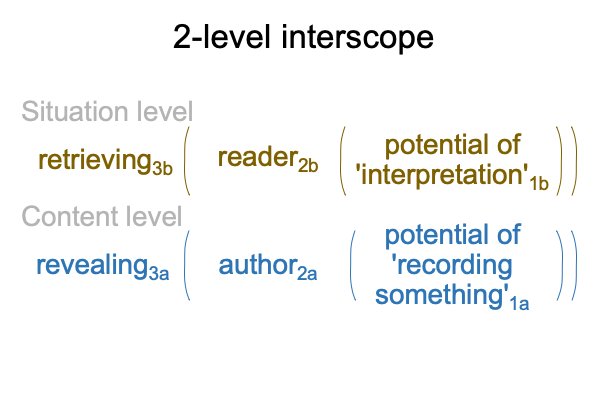0030 In chapter two, Mark Smith addresses the question, “What is the original sin in Genesis 3, according to Scripture and Christian theologians?”
What do the authors of Wisdom of Solomon 2:24, as well as Saint Paul, Saint Augustine and John Calvin, retrieve from Genesis 3?
0031 What do I mean by the word, “retrieve”?
The reader is an actuality2b, virtually situating the author2a, the intersection of insight2V and conditions2H. The reader2bemerges from (and situates) the potential of interpretation1b, in the normal context of retrieve3b.
Ah, the reader2b retrieves the author2a’s insights2V and conditions2H.
0032 The two-level interscope is introduced in A Primer on Sensible and Social Construction (available at the smashwords website and other sites that market e-works).
Here is a picture for the reader and the author.

0033 Deuterocanonical texts, such as the Wisdom of Solomon, are not clear about the nature of Adam and Eve’s transgression.
Neither is Saint Paul, who writes a typology. Adam is the type of the one who fell. Jesus is the type of the one who is risen.
0034 Saint Augustine proposes that original sin arises in the realm of potential within Adam and Eve, then enters into actuality after the serpent closes the pitch. Yes, the sales pitch. The potential consists of pride, welling up within Adam and Eve. It is like a boil. First, it wells up below the surface. Then, it ruptures.
Augustine concludes that an infection of pride condemns all of us because we are all descendants of Adam and Eve. Original sin is like a sexually transmitted disease.
Augustine’s diagnosis… er… interpretation covers both insight2V and conditions2H. The insight2V is pride as a motive for sin. The condition2H is infection and transmission.
0035 John Calvin, after assessing many options, claims that the sin of Adam’s transgression is unfaithfulness. His approach to this conclusion is noteworthy. He retrieves early Christian authors. Then, he retrieves the gospels and letters of Paul. Then he retrieves the Old Testament. What does he unearth? Mark Smith is precise, saying, “The understanding of the conditions of human sin informs Calvin’s understanding of the origins of sin.” Calvin illuminates conditions2H.
0036 So, Adam’s transgression is like a pustulating infection2V, where pride seethes beneath the surface then ruptures into rebellion against God’s command. The conditions2H are unfaithfulness. Then, the infection transmits from one generation to the next, through acts of procreation.
